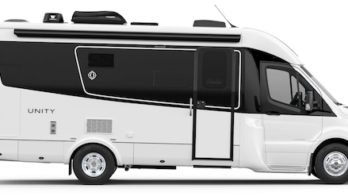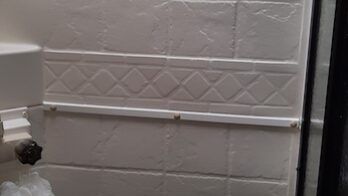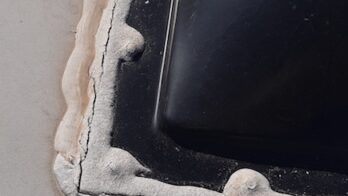
Warning! There is a risk of burn, electric shock, sharp object injuries, and pressure related injuries when working with RV water heaters and other RV appliances.
RV appliances and RV refrigerators, especially absorption type refrigerators using propane must be installed and operated according to manufacturers’ instructions. Many RV appliances contain sharp metal pieces which may cause open-wound injuries. Water pressure inside RV water heaters may cause projectile related injuries to eyes. Only proceed with RV water heater maintenance and repairs when it can be verified that there is no hot water inside the water heater and the town water pressure and RV fresh water pump pressure is shut off.
Risk of electrical shock is possible with most RV refrigerators, water heaters, air conditioners, light fittings, and any appliance located on the 120 volt AC circuit. Solar inverters can create 120 volt AC current without being connected to a 120 volt power source. It is recommended to consult a certified electrician or RV professional before attempting any work on or around RV appliances. Internal water temperatures of water heaters may reach near boiling temperature. Ensure the water in the water heater is cool before operating on the water heater. Either allow the water to cool over at least 12 hours with no power or propane supplied to the heater, or switch off all power and propane supplies and run a hot water faucet for ten minutes to drain all hot water and replenish with cool water. Shut off town water supply and switch off the fresh water pump inside the RV so that there is no risk of projectile injuries from water pressure. Wear protective gloves to avoid risk of skin injuries from sharp metal pieces. Eye protection should be worn to prevent projectile injuries from water pressure.
RV Water heaters, RV furnaces, RV refrigerators, and RV stoves running on propane present certain risks. Leaking propane carries a risk of ignition or even explosion in confined spaces. Propane produces carbon monoxide when burning. Carbon monoxide is an odourless gas which is toxic and may cause death. Properly installed propane appliances are safe when operated according to manufacturers’ instructions. Performing maintenance and repairs can increase the risk of leaks in the propane system.
Propane systems that are opened by loosening connections, defective connections, broken hoses or piping, or are improperly installed with loose fittings may leak and create the risk of explosion or fire. Propane systems must be tested for leaks using industry standards. Firstly, leaks should be tested using a liquid soap sprayed to joints, elbows, and connections. If bubbles form from the liquid soap, there is immediate evidence of leaking. This is not conclusive because there may be a very slow leak which does not generate bubbles or a leak may eventuate after the liquid has dried, due to vibration or movement. Leaks can also be tested by a gas sniffer device, but this is also a momentary check. The final test for leaks is determined by a timed pressure test. A manometer is connected to the propane system and the test must maintain a pressure rating of at least eight inches of water column for a minimum of five minutes over three separate five minute testing periods.
Propane is mixed with an odour inducing gas called methyl mercaptane. This gas creates a pungent odour which can be a guide for detecting gas leaks. Propane is heavier than air and will infiltrate underfloor cavities, lower floor spaces and inside cupboards. Should these confined spaces trap enough propane, the accumulated propane can be an ignition source or present a risk for explosion. If propane is detected, open all doors and windows and vacate the RV immediately. Shut off the propane supply at the source as soon as possible.
A propane detector is required. Propane detectors must be installed in low positions to sense propane near floor level. Manufacturers provide detailed instructions for installation. Propane detectors have a useful period of activation which varies between makes and models. A date is stamped to the back of the device as a guide to the approximate time of useful life. Propane detectors usually begin their useful time at the point of first power connection. If the power connection is disconnected for any period of time, the time period is still relevant to the very first starting time and ignores any period of disconnected time. Useful time periods of five years or more are possible, but the final time period is based on the manufacturers’ time stamp and the determined useful time period written on the device. An alarm usually signals the final time of expiration. Any expired propane detector should be replaced with a new device immediately.
Portable propane heaters, flexible hoses, and propane cylinders and tanks must always be used outside of any confined spaces and never used inside an RV. Some propane appliances are manufactured for use inside RVs and must be used only as directed by the manufacturers’. Tanks, cylinders, portable appliances, and flexible hoses must always be used in open air situations where propane cannot accumulate.
RV furnaces operate with propane combustion and are safe when installed and operated following manufacturers’ instructions. While risks are minimized with normal operation, maintenance inspections are recommended according to manufacturers’ instructions to ensure proper venting of exhaust gases.
RV appliances including RV furnaces, RV refrigerators, and water heaters contain safety devices including extreme temperature limit switches, blower sail switch, fuses, fusible links, and dual gas valves which shut down automatically when power is cut. These devices must be fully operational at all times and must never be bypassed or disabled.
Ensuring your RV appliances are fully serviced, maintained and used following all manufacturers’ recommendations will offer safe and enjoyable use of your RV.
Access to roof appliances including air conditioners, roof vents, and solar panels is very risky. There is no safety fencing on an RV roof. It is recommended to use a sturdy ladder. The fixed ladders on RVs may be mounted to decaying wood behind the RV’s exterior panels, so care must be taken to avoid the built-in ladder from collapsing. Ensure you practise safe ladder handling. When on the roof, the RV is subject to movement and shaking which is amplified on the roof. This may cause a falling hazard from being unbalanced. There are also slipping and tripping hazards too. Do not proceed to an RV roof when it is wet or treated with a slippery solution. It is recommended to only crawl on hands and knees when on an RV roof.
Make sure you check that you have removed all tools, remnant caulk and materials, and parts from an RV roof after finishing repairs and installations. Loose tools and materials remaining on the roof can cause significant damage to other property when the RV is in motion.



Recent Comments